Study of Specific Problems Arising in the Blending Processes of Crude Oils (Based on the Examples of Azerbaijan Oils)
Abstract
1. Introduction
2. Materials and Methods
3. Results
4. Conclusions
- Based on the examples of Azerbaijan crude oil, it has been established that mixtures of oil containing high-molecular-weight compounds (resins, paraffins, asphaltenes) do not follow the rule of additivity, and exhibit anomalous changes in quality indicators.
- It was revealed that mixing rheologically complex, heavy crude oil with condensate is not advisable when the condensate content is less than 20%. Otherwise, due to an increase in the freezing point of the oil, the transportation process may become significantly more difficult or even potentially cease.
- The importance of considering the significant impact of oil blending on quality indicators was emphasized. Furthermore, the necessity of rational blending to ensure efficient transportation was also highlighted.
- Depending on the type of oil and blending ratio, it was found that the demulsifier consumption during demulsification of oil emulsions varies within a wide range. The possibility of determining the optimal demulsifier consumption by considering the resulting synergistic effect was demonstrated.
- It was determined that certain mixtures of rheologically complex crude oils in specific ratios are “incompatible”. For such mixtures, transportation was found to be significantly complicated or even unfeasible.
Author Contributions
Funding
Data Availability Statement
Conflicts of Interest
References
- Nurullayev, V.; Ismailov, G.; Usubaliyev, B. Increasing the Efficiency of Oil and Petroleum Products by the Application of Nano-Chemical and Cavitation Technologies; Scholars Press: Chico, CA, USA, 2018; p. 124. [Google Scholar]
- Bowman, R.W.; Burton, W.D.; Pyor, J.A.; Shell Oil Co. Statistically Designed Oil Dehydration Test. In Proceedings of the SPE California Regional Meeting, Bakersfield, CA, USA, 13–15 April 1977. SPE Paper 6529. [Google Scholar]
- Ismayilov, G.G.; Iskanderov, E.K.; Fataliyev, V.M.; Gurbanov, A.G.; Ismayilova, F.B. Some aspects for improving the efficiency of the development of offshore resources in marine conditions. SOCAR Proc. 2023, 4, 99–105. [Google Scholar] [CrossRef]
- Iskanderov, E.K.; Ismayilova, F.B.; Shukurlu, M.F.; Ismayilova, P.S. Changes in the energy characteristics of pipeline systems considering hydrodynamic loads. SOCAR Proc. 2024, 2, 105–108. [Google Scholar] [CrossRef]
- Poindexter, M.K.; Chuai, S.; Marble, R.A.; Marsh, S.C.; Ondeo Nalco Energy Services. Classifying Crude Oil Emulsions Using Chemical Demulsifiers and Statistical Analyses. In Proceedings of the SPE Annual Technical Conference and Exhibition, Denver, CO, USA, 5–8 October 2013. SPE Paper 84610. [Google Scholar]
- Ismayilov, G.; Ismayilova, H.; Babirov, H.; Jabrayilova, R. Assessment of environmental oil spills and economic-environmental risks. Reliab. Theory Appl. 2022, 17, 212–217. [Google Scholar]
- Rodriguez-Abreu, C.; Delgado-Linares, J.G.; Bullon, J. Properties of Venezuelan Asphaltenes in the Bulk and Dispersed State. J. Oleo Sci. 2006, 55, 563–571. [Google Scholar] [CrossRef]
- Rogel, E. Studies on asphaltene aggregation via computational chemistry. Colloids Surf. A Physicochem. Eng. Asp. 1995, 104, 85–93. [Google Scholar] [CrossRef]
- Saniere, A.; Hénaut, I.; Argillier, J.F. Pipeline Transportation of Heavy Oils: A Strategic, Economic and Technological Challenge. Oil Gas Sci. Technol.—Rev. IFP 2004, 59, 455–466. [Google Scholar] [CrossRef]
- Serfass, J.P.; Joly, A.; Samanos, J. SBS-modified asphalts for surface dressing in Polymer Modified Asphalt Binders. In Polymer Modified Asphalt Binders; ASTM STP 1108; ASTM International: West Conshohocken, PA, USA, 1992. [Google Scholar]
- Wang, X.; Gurbanov, H.; Adygezalova, M.; Alizade, E. Investigation of Removing Asphaltene-Resin-Paraffin Deposits by Chemical Method for Azerbaijan High-Paraffin Oil Production Process. Energies 2024, 17, 3622. [Google Scholar] [CrossRef]
- Evdokimov, I.N.; Eliseev, D.Y.; Eliseev, N.Y. Negative viscosity anomaly of liquid petroleum products after thermal treatment. Chem. Technol. Fuels Oils 2006, 3, 26–29. (In Russian) [Google Scholar]
- Evdokimov, I.N. T-C Phase Diagram of Asphaltenes in Solutions. Pet. Sci. Technol. 2007, 25, 5–17. [Google Scholar] [CrossRef]
- API MPMS 12.3; Manual of Petroleum Measurement Standards; Chapter 12-Calculation of Petroleum Quantities; Section 3—Volumetric Shrinkage Resulting from Blending Light Hydrocarbons with Crude Oils. American Petroleum Institute (API): Washington, DC, USA, 1996.
- Shanshool, J.; Talib, E. Fitted Shrinkage Formula of Spiked Crude Oils. Pet. Sci. Technol. 2002, 20, 435–439. [Google Scholar] [CrossRef]
- Evdokimov, I.N.; Eliseev, N.Y.; Losev, A.P.; Novikov, M.A. Promising oil and gas nanotechnologies for field development. In Proceedings of the SPE Russian Oil and Gas Technical Conference and Exhibition. World of Technologies for Unique Resources, Moscow, Russia, 3–6 October 2006. CD-ROM edition (In Russian). [Google Scholar]
- Wiehe, I.A. Crude Oil Compatibility. In Proceedings of the Crude Oil Quality Group Meeting, Houston, TX, USA, 2 October 2003; Available online: https://www.coqg.org/20031002SolubleSolutions.pdf (accessed on 10 September 2024).
- Wong, G.K.; Yen, T.F. An electron spin resonance probe method for the understanding of petroleum asphaltene macrostructure. J. Pet. Sci. Eng. 2000, 28, 55–64. [Google Scholar] [CrossRef]
- Wu, J.; Prausnitz, J.M.; Firoozabadi, A. Molecular-Thermodynamic Framework for Asphaltene-Oil Equilibria. AIChE J. 1998, 44, 1188–1199. [Google Scholar] [CrossRef]
- Li, S.; Fan, K.; Huang, Q. Evaluation of stability for flowing water-in-oil emulsion in transportation pipeline. J. Pet. Sci. Eng. 2022, 216, 110769. [Google Scholar] [CrossRef]
- Galimzyanov, B.N.; Doronina, M.A.; Mokshin, A.V. Unified scaling model for viscosity of crude oil over extended temperature range. Fuel J. 2025, 379, 133018. [Google Scholar] [CrossRef]
- Alonso, F.; Castillo, J.A.; Ancheyta, J.; Torres-Mancera, P. Evaluation of the Effect of Addition Order on the Compatibility of Binary Crude Oil Blending. Energy Fuels J. 2024, 38, 23358–23366. [Google Scholar] [CrossRef]
- GOST 3900-2022; Petroleum Products. Methods for Determination of Density. Federal Agency for Technical Regulation and Metrology (Rosstandart): Moscow, Russia, 2022.
- GOST 33-2016; Petroleum Products. Transparent and Opaque Liquids. Determination of Kinematic Viscosity and Calculation of Dynamic Viscosity. Federal Agency for Technical Regulation and Metrology (Rosstandart): Moscow, Russia, 2016.
- GOST 11858-2008; Petroleum Products. Method for the Determination of Asphaltic Resinous Substance Content. Federal Agency for Technical Regulation and Metrology (Rosstandart): Moscow, Russia, 2008.
- GOST 11851-2018; Petroleum Products. Methods for Determination of Paraffin Content. Federal Agency for Technical Regulation and Metrology (Rosstandart): Moscow, Russia, 2018.
- GOST 1756-2000; Determination of Saturated Vapour Pressure. Federal Agency for Technical Regulation and Metrology (Rosstandart): Moscow, Russia, 2000.
- GOST 20287-2023; Petroleum Products. Methods of Test for Freezing Point. Federal Agency for Technical Regulation and Metrology (Rosstandart): Moscow, Russia, 2023.
- GOST 6370-2018; Petroleum, Petroleum Products and Additives. Method for Determination of Mechanical Admixtures. Federal Agency for Technical Regulation and Metrology (Rosstandart): Moscow, Russia, 2018.
- GOST 21534-2021; Petroleum Products. Methods for Determination of Chlorine Salts. Federal Agency for Technical Regulation and Metrology (Rosstandart): Moscow, Russia, 2021.
- GOST 2477-2014; Petroleum and Petroleum Products. Method for Determination of Water Content. Federal Agency for Technical Regulation and Metrology (Rosstandart): Moscow, Russia, 2014.
- Mushrush, G.; Speight, J.G. Petroleum Products: Instability and Incompatibility; Applied Energy Technology Series; Taylor & Francis: Bristol, PA, USA, 1995; 390p. [Google Scholar]
- Evdokimov, I.N. Bifurcated correlations of the properties of crude oils with their asphaltenes content. Fuel 2005, 84, 13–28. [Google Scholar] [CrossRef]
- Ismayilov, Q.Q.; Nurmammadova, R.Q.; Zeynalov, R.L. On the trends of synergism and antagonism during the accumulation and transportation preparation of crude oil blends. Azerbaijan Oil Econ. J. 2014, 4, 31–34. [Google Scholar]

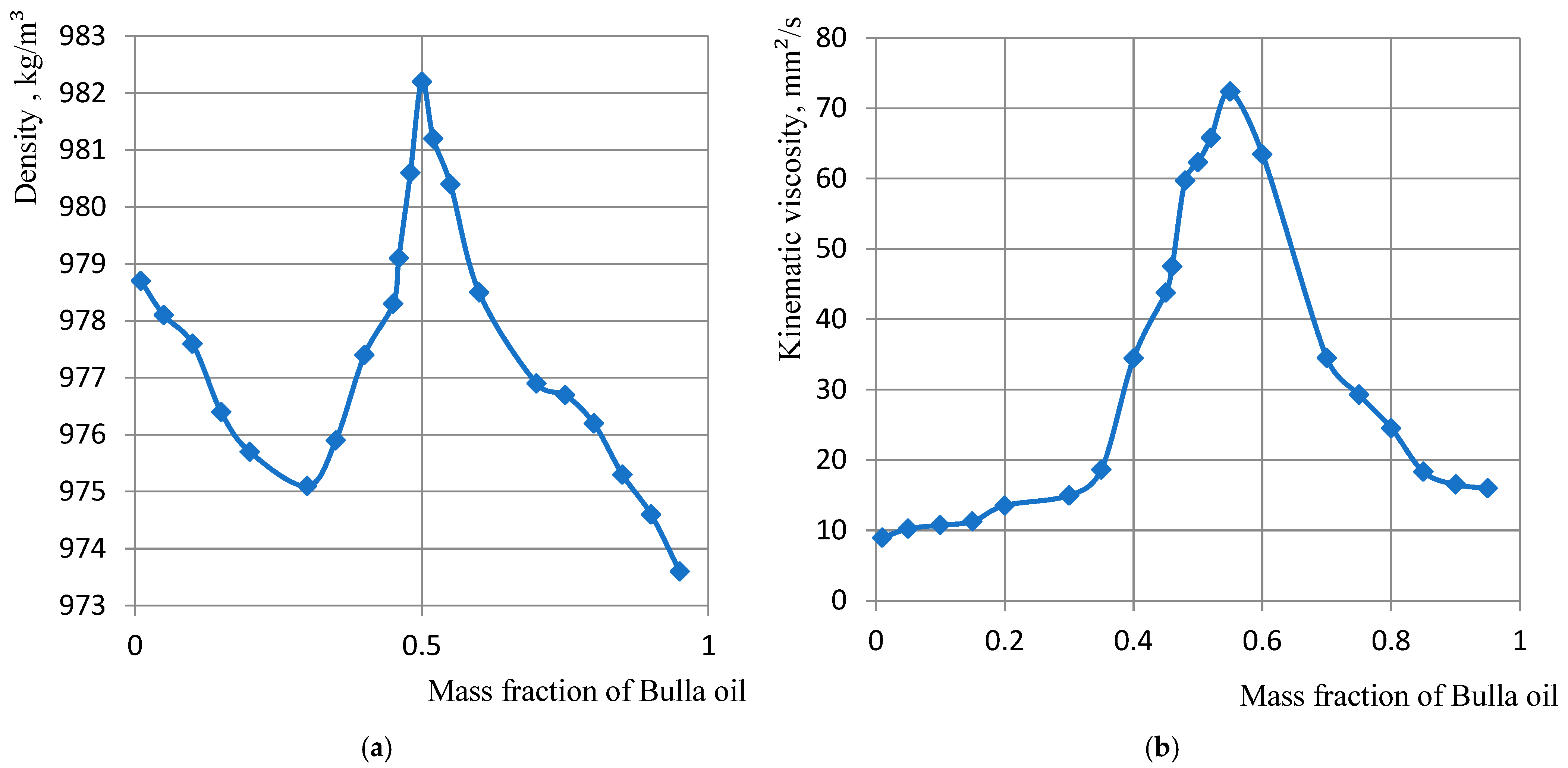
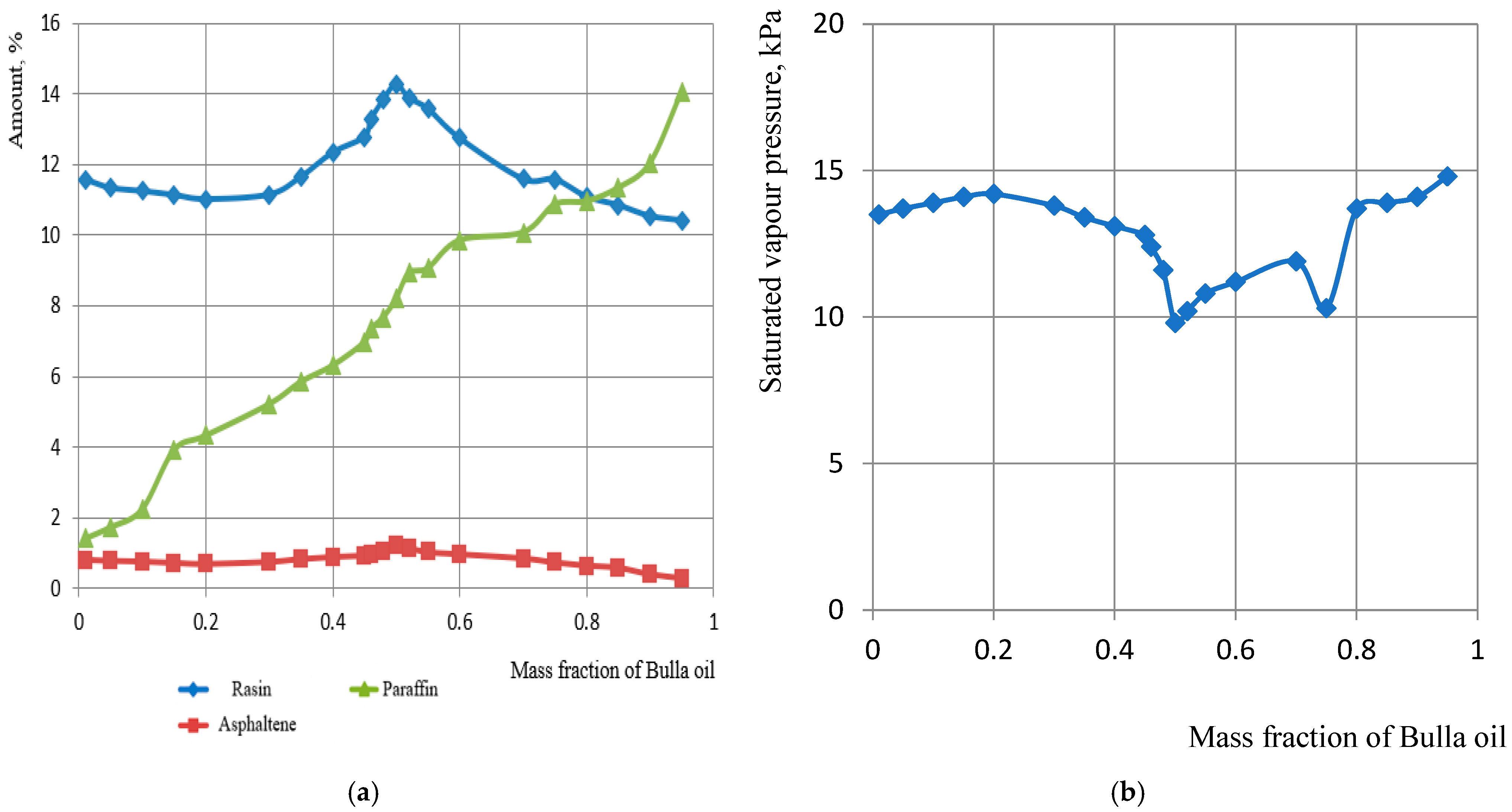
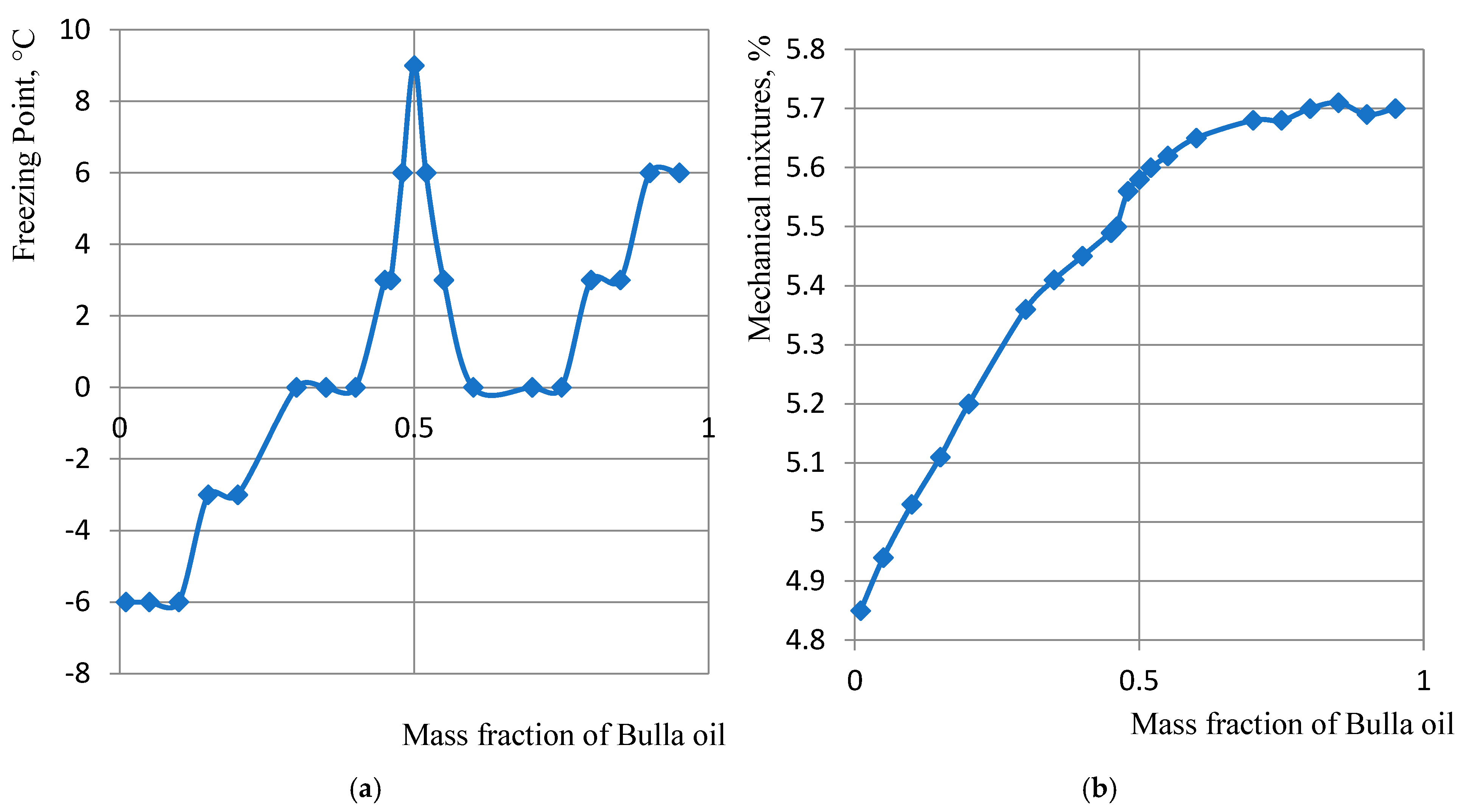
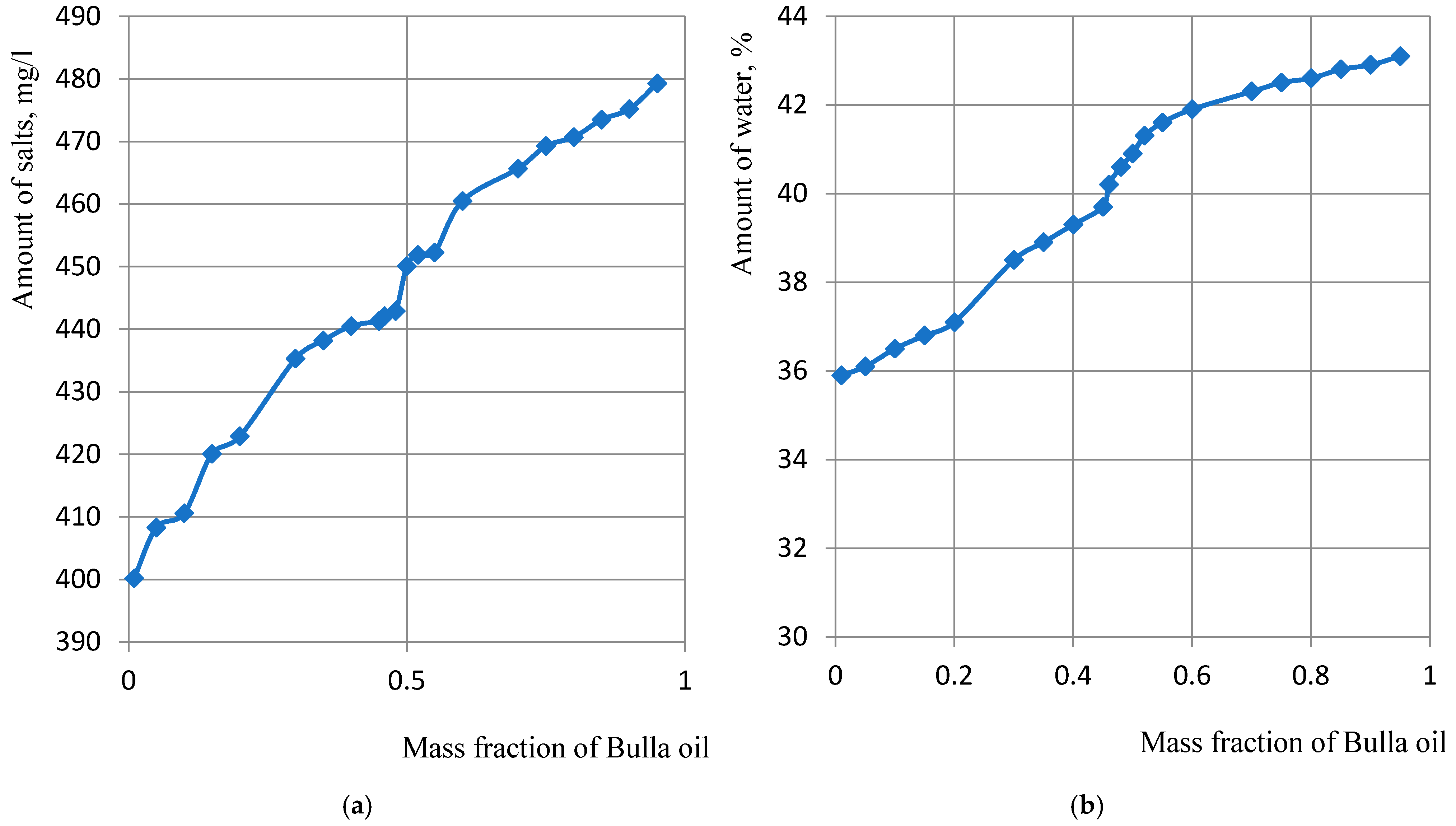
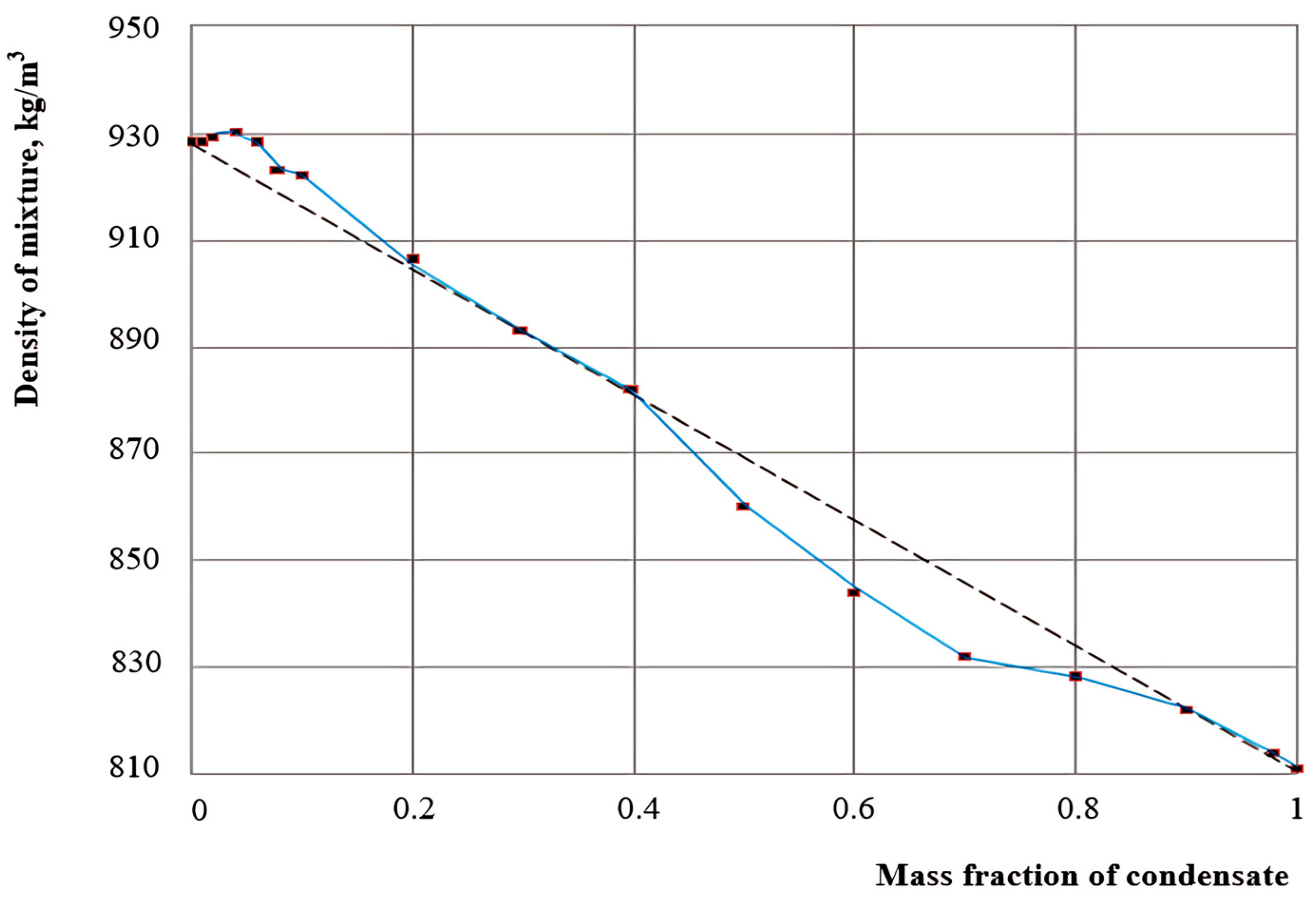

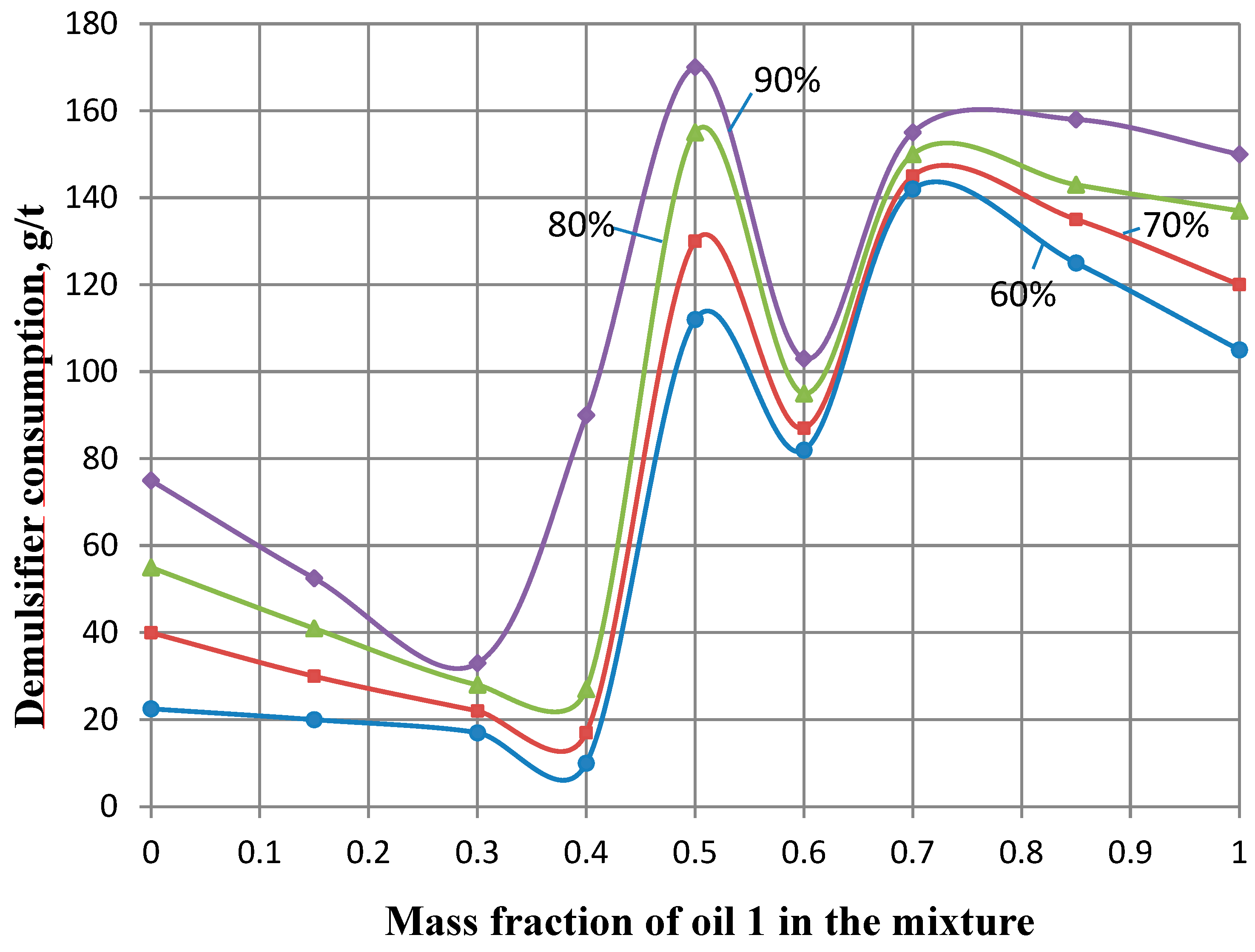
| Indicators | BN | SN | Analysis Methods |
|---|---|---|---|
| Density (at 20 °C), kg/m3 | 973.4 | 978.9 | GOST 3900-2022 [23] |
| Kinematic Viscosity, mm2/s | 15.76 | 8.23 | GOST 33-2016 [24] |
| Resin, % | 10.27 | 11.12 | Chromatograph |
| Asphaltene, % | 0.23 | 0.81 | GOST 11858-2008 [25] |
| Paraffin, % | 13.34 | 1.18 | GOST 11851-2018 [26] |
| Saturated Vapor Pressure, kPa | 16.2 | 13.9 | GOST 1756-2000 [27] |
| Freezing Point, °C | +9 | −6 | GOST 20287-2023 [28] |
| Mechanical Mixtures, % by mass | 5.72 | 4.83 | GOST 6370-2018 [29] |
| Salts (by mass), mg/L | 481.3 | 400.0 | GOST 21534-2021 [30] |
| Water Content, % by mass | 35.1 | 43.7 | GOST 2477-2014 [31] |
| Indicators | Mass Fraction of BN, βBN | ||||||||||
|---|---|---|---|---|---|---|---|---|---|---|---|
| 0.01 | 0.05 | 0.10 | 0.15 | 0.20 | 0.30 | 0.35 | 0.40 | 0.45 | 0.46 | 0.48 | |
| Density, kg/m3 | 978.7 | 978.1 | 977.6 | 976.4 | 975.7 | 975.1 | 975.9 | 977.4 | 978.3 | 979.1 | 980.6 |
| Viscosity, mm2/s | 8.97 | 10.23 | 10.76 | 11.27 | 13.54 | 14.97 | 18.65 | 34.46 | 43.81 | 47.53 | 59.71 |
| Resin, % by mass | 11.58 | 11.34 | 11.25 | 11.14 | 11.02 | 11.15 | 11.65 | 12.34 | 12.78 | 13.27 | 13.84 |
| Asphaltene, % by mass | 0.81 | 0.78 | 0.76 | 0.72 | 0.69 | 0.75 | 0.83 | 0.89 | 0.93 | 0.95 | 1.06 |
| Paraffin, % by mass | 1.43 | 1.75 | 2.26 | 3.93 | 4.34 | 5.23 | 5.86 | 6.32 | 6.98 | 7.35 | 7.68 |
| Saturated Vapor Pressure, kPa | 13.5 | 13.7 | 13.9 | 14.1 | 14.2 | 13.8 | 13.4 | 13.1 | 12.8 | 12.4 | 11.6 |
| Freezing Point, °C | −6 | −6 | −6 | −3 | −3 | 0 | 0 | 0 | +3 | +3 | +6 |
| Mechanical Mixtures, % by mass | 4.85 | 4.94 | 5.03 | 5.11 | 5.20 | 5.36 | 5.41 | 5.45 | 5.49 | 5.50 | 5.56 |
| Amount of Salts (by mass), mg/L | 400.2 | 408.3 | 410.6 | 420.1 | 422.9 | 435.3 | 438.2 | 440.5 | 441.3 | 442.1 | 442.9 |
| Water Content, % by mass | 35.9 | 36.1 | 36.5 | 36.8 | 37.1 | 38.5 | 38.9 | 39.3 | 39.7 | 40.2 | 40.6 |
| Indicators | Mass Fraction of BN, βBN | ||||||||||
| 0.5 | 0.52 | 0.55 | 0.60 | 0.70 | 0.75 | 0.80 | 0.85 | 0.90 | 0.95 | ||
| Density, kg/m3 | 982.2 | 981.2 | 980.4 | 978.5 | 976.9 | 976.7 | 976.2 | 975.3 | 974.6 | 973.6 | |
| Viscosity, mm2/s | 62.32 | 65.78 | 72.37 | 63.48 | 34.5 | 29.31 | 24.53 | 18.34 | 16.54 | 15.98 | |
| Resin, % by mass | 14.28 | 13.89 | 13.58 | 12.75 | 11.59 | 11.58 | 11.09 | 10.85 | 10.54 | 10.42 | |
| Asphaltene, % by mass | 1.23 | 1.15 | 1.03 | 0.97 | 0.85 | 0.73 | 0.64 | 0.58 | 0.39 | 0.28 | |
| Paraffin, % by mass | 8.21 | 8.93 | 9.07 | 9.86 | 10.08 | 10.87 | 10.96 | 11.34 | 12.04 | 14.06 | |
| Saturated Vapor Pressure, kPa | 9.8 | 10.2 | 10.8 | 11.2 | 11.9 | 10.3 | 13.7 | 13.9 | 14.1 | 14.8 | |
| Freezing Point, °C | +9 | +6 | +3 | 0 | 0 | 0 | +3 | +3 | +6 | +6 | |
| Mechanical Mixtures, % by mass | 5.58 | 5.60 | 5.62 | 5.65 | 5.68 | 5.69 | 5.70 | 5.71 | 5.69 | 5.70 | |
| Amount of Salts (by mass), mg/L | 450.1 | 451.9 | 452.3 | 460.5 | 465.7 | 469.3 | 470.7 | 473.5 | 475.2 | 479.3 | |
| Water Content, % by mass | 40.9 | 41.3 | 41.6 | 41.9 | 42.3 | 42.5 | 42.6 | 42.8 | 42.9 | 43.1 | |
| Indicators | Condensate Sample | Oil Samples | Mixture of 1st and 2nd Oil Emulsions | |
|---|---|---|---|---|
| Oil 1 | Oil 2 | 50%:50% | ||
| Density, at 20 °C, kg/m3 | 810.0 | 930.6 | 976.5 | 952.7 |
| Kinematic viscosity, at 20 °C, mm2/s | 7.60 | No flow | No flow | No flow |
| Amount of water, % | Traces | 34 | 75 | 54 |
| Chlorine salts, mg/dm3 | 7.31 | 1300.07 | 1214.41 | 1304.94 |
| Mechanical mixtures, % | 0.335 | 0.200 | 0.168 | 0.219 |
| Freezing Point, °C | −1.6 | +28 | +24 | +28 |
| Paraffin, % | 0.06 | 5.5 | 6.4 | 6.0 |
| Resin, % | 2.29 | 2.2 | 3.1 | 2.7 |
| Asphaltene, % | 0.12 | 7.1 | 11.0 | 9.0 |
| Indicators | Mass Fraction of Condensate, βcon | |||||||||||
|---|---|---|---|---|---|---|---|---|---|---|---|---|
| 0 | 0.02 | 0.04 | 0.06 | 0.08 | 0.1 | 0.2 | 0.4 | 0.6 | 0.8 | 0.9 | 1 | |
| Density, at 20 °C, kg/m3 | 930 | 930 | 931 | 929 | 923 | 921 | 907 | 882 | 844 | 829 | 822 | 810 |
| Freezing point, °C | 19 | 20 | 21 | 23 | 22 | 17.5 | 16 | 12.5 | 10 | 7 | 5 | 4 |
| Mechanical mixtures, % | 0.368 | 0.367 | 0.366 | 0.365 | 0.364 | 0.363 | 0.361 | 0.355 | 0.348 | 0.342 | 0.334 | 0.335 |
| Chlorine salts, mg/dm3 | 1133.67 | 1097.1 | 1053.22 | 1038.59 | 1031.27 | 1015.16 | 886.476 | 667.24 | 378.84 | 195.7 | 37.88 | 7.31 |
| Kinematic viscosity, at 20 °C, mm2/s | No flow | No flow | 347.16 | 325.17 | 207.41 | 151.71 | 122.5 | 40.4 | 18.9 | 10.3 | 7.6 | 7.6 |
Disclaimer/Publisher’s Note: The statements, opinions and data contained in all publications are solely those of the individual author(s) and contributor(s) and not of MDPI and/or the editor(s). MDPI and/or the editor(s) disclaim responsibility for any injury to people or property resulting from any ideas, methods, instructions or products referred to in the content. |
© 2025 by the authors. Licensee MDPI, Basel, Switzerland. This article is an open access article distributed under the terms and conditions of the Creative Commons Attribution (CC BY) license (https://creativecommons.org/licenses/by/4.0/).
Share and Cite
Wang, X.; Ismayilov, G.; Iskandarov, E.; Alizade, E.; Ismayilova, F. Study of Specific Problems Arising in the Blending Processes of Crude Oils (Based on the Examples of Azerbaijan Oils). Processes 2025, 13, 1500. https://doi.org/10.3390/pr13051500
Wang X, Ismayilov G, Iskandarov E, Alizade E, Ismayilova F. Study of Specific Problems Arising in the Blending Processes of Crude Oils (Based on the Examples of Azerbaijan Oils). Processes. 2025; 13(5):1500. https://doi.org/10.3390/pr13051500
Chicago/Turabian StyleWang, Xiuyu, Gafar Ismayilov, Elman Iskandarov, Elnur Alizade, and Fidan Ismayilova. 2025. "Study of Specific Problems Arising in the Blending Processes of Crude Oils (Based on the Examples of Azerbaijan Oils)" Processes 13, no. 5: 1500. https://doi.org/10.3390/pr13051500
APA StyleWang, X., Ismayilov, G., Iskandarov, E., Alizade, E., & Ismayilova, F. (2025). Study of Specific Problems Arising in the Blending Processes of Crude Oils (Based on the Examples of Azerbaijan Oils). Processes, 13(5), 1500. https://doi.org/10.3390/pr13051500






